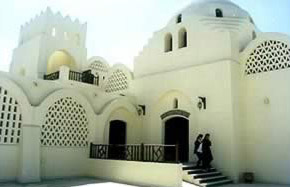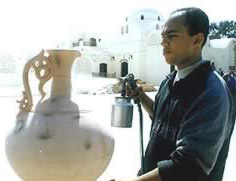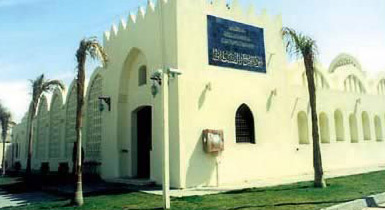The Egyptian Porcelain Center is a new beacon of culture and art that enables talented artists, researchers and artisans to delve into the great Egyptian heritage, emphasizing its identity and reviving its time-honored heritage. The center shoulders the responsibility of cultivating conventional handicrafts that have thrived over earlier epochs. On April 23, 2001, Mrs. Suzanne Mubarak inaugurated the Porcelain center in the Islamic district of Cairo , Al-Fustat.
Cultural Site
The new center was founded in 1996, on the remains of a small building of the earlier porcelain center in al-Fustat in the center of old Cairo, built by the Ministry of Culture in 1958 to revive the art of pottery and ceramics. As this area was famous for those handicraft, the center was built there as a training and formation center for young generations of craftsmen, potters and ceramists.
Source of Radiation
Since then, the center has been a bee-hive for talented artisans, whose works were characteristic of perfection, creativity and adherence to the spirit of heritage.
The center participates with its unique productions in major international conventional handicrafts festivals; at 4 or 5 festivals every year.
All these were good reasons to build a new and larger center equipped with advanced technology to regain the historical role of al-Fustat in the field of porcelain art and industry. This would also disseminate aesthetic and artistic values among the general public, upgrade these handicraft and protect them against extinction.
The center was designed as a meeting - point between Egyptian and international artists through exchanging experience, hosting world artists to carry out their experiments and research and organize workshops with talented young Egyptian artists.

In the light of this concept, the following has been carried out:
Building 7 studios with full-board accommodation facilities for resident creative potters. To facilitate their work, workshops fully equipped with tools, equipment, materials and different kinds of furnaces were provided. Artists and artisans were encouraged to produce creative works as models for researches and ceramics workers.
A museum of a magnificent architectural design, characterized by a new style of displaying works of porcelain was built. Outstanding in-house works will be displayed together with those by guest artists as well as through periodical workshops. These works are usually characterized with creativity, research and experimentation. Thus, the museum will always present unique exhibits in terms of intellectual content and technique. A gallery for variable exhibitions was provided as an outlet for exhibition of prominent artists and future porcelain arts.
A large auditorium equipped with sound systems, video-screen and projectors, was assigned for watching works of art and holding periodical seminars in the field of conventional crafts and arts.
A library containing various art books was established for the use of plastic arts researchers.
A mosaic department was introduced so as to revive and disseminate this genuine Arab art that flourished over all Islamic eras in mosques, houses and public squares.
The Centers workshops were fully equipped with tools, machines, materials and furnaces necessary for work, production and carrying out experiments and researches. In the clay preparation department, a large mixer was installed, together with basins and sieves with gradated mesh. The painting and decoration department was provided with a great number of rolling easels of various lengths, painting and ornamentation tools and all kinds of coloring oxides, in addition to glass paint cabins. Workshops were furnished with all kinds of trays used in burning porcelain in different techniques.
Wonderful location
The Porcelain Center in Fustat is located in the heart of Misr al-Qadima (old Cairo) distinct. This art center or museum is really a new outlet for Egyptian and world porcelain artists as well as a magnificent manifestation of historical Cairo architecture. The museums building, in itself, is a piece of sheer aesthetic value that enriches the eye. The museum is expected to be an active venue for ceremonies, festivals and exhibitions, besides various creativity workshops.

The Fustat Porcelain Center is situated in a significant location in old Cairo district; amidst monuments including Amr Ibn Aas Mosque, group of churches and Ibn Ezer temple. The adjoining area is full of craftsmen, artisans. This qualifies the center to a source of cultural radiation as well as guardian of porcelain and pottery heritage.
Future Plan
The future plan for the project allows for adding a number of services and opens to accommodate artistic as well as tourist activities that is increasing in the district. These additional services include:
An open area in the center of the project with a huge fountain adequate for international celebrations and festivals such as Avinion in France.
An open theatre and amphitheater surrounded by open stone arcades reflecting the prevailing architectural style of the place. Through these arcades it is possible to see the remains of the old Fustat city, thus adding a historical dimension to the present. It can also be used as an open theatre for cultural and artistic celebrations.
Saied as-Sadr Museum, was founded 40 years ago by the famous Egyptian ceramic artist to display his works and those of pioneer potters, in addition to an art gallery museum and an outlet for selling the centers products, souvenirs and artistic reproductions.
A cafeteria and coffee shop on the top of the tower where visitors can have a complete panoramic view of the historical area of old Cairo.
Adam Henein by Lara Iskander
Arabic Music by David Scott
Ahmed Askalany's Incredible Palms by Heba Fatteen Bizzari
A Bedouin Dinner in the Sinai by Julia Kaliniak
Cairo's Gold Mine of Used Books Still Offers Treasures by Dr. Maged El-Bialy
Children in Modern Egypt by Catherine C. Harris
Coptic Christians of Egypt, An Overview of the by Lara Iskander and Jimmy Dunn
Egypt's 1960s Remarkable Virgin Mary Sightings by Amargi
Egyptian Arabic by Jimmy Dunn writing as Ismail Abaza
Egyptian Food by Joyce Carta
Egyptian Hajj Painting by Sonny Stengle
The Egyptian Middle Class by Jimmy Dunn
Egyptian Porcelain Center: A New Showcase for Egyptian and World Artists by The Egyptian Government
The Egyptian Wedding by Dr. Maged El-Bialy
Eid: Celebration for the Young and Old by Mohamed Osama
Islam in a Nutshell by Seemi AhmadIslam
Koshary by Heba Fatteen Bizzari
The Legends of the Cretan House by Dr. Maged El-Bialy
Marvelous Melokiyah by Mary Kay Radnich
El Misaharaty: The Ramadan Drummers by Heba Fatteen Bizzari
Modern Egyptian Houses by the Egyptian Government
Modern Egyptian Pottery by the Egyptian Government
Moulids! by Lara Iskander
The Mysteries of Qurna by Sonny Stengle
Naquib Mahfouz's Classic: Bedaya Wa Nihaya, A Review by Adel Murad Naquib Mahfouz (1911-August 30th, 2006)
Never Mind, Just Crossing the Moon By Arnvid Aakre
On Understanding Egypt by Ralph Ellis
Party for the God in Luxor by Jane Akshar
Egypt's Rafat Wagdy by Heba Fatteen Bizzari
Ramadan in Al Hussein Square by Seif Kame
lRamadan in Egypt by Sameh
Ramadan in Korba, Heliopolis by Seif Kamel
Ramadan Lanterns in Egypt by Heba Fatteen Bizzari
The 8th Annual Scupture Symposium for Stone in Aswan by The Government of Egypt with revisions by Jimmy Dunn
The Sebou Ceremony Welcoming a New Born Baby in Egypt by Heba Fatteen Bizzari
Sham el Nessim, Egypt Spring Festival by Heba Fatteen Bizzari
Sheikh Yusuf al-Haggag, His Mosque and Moulid In Luxor by Jane Akshar
Umm Kalthoum by Lara Iskander
You Don't Have to Go to the Khan El-Khaliliby Dr. Maged El-Bialy
The Zar Ceremony by Heba Fatteen Bizzari
